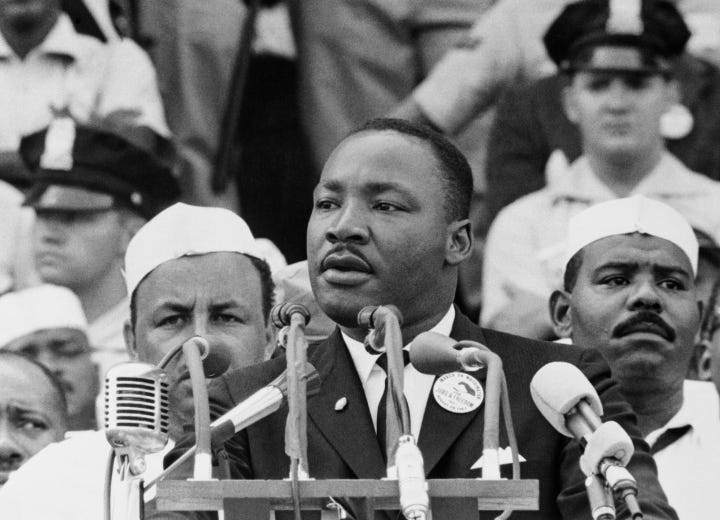‘‘Martin Luther King Jr. proved that grassroots movements, fueled by unity and nonviolence, can dismantle tyranny. His leadership in the Civil Rights Movement led to historic change, reminding us that collective action and moral courage remain powerful tools for justice and equality.’’
Throughout history, tyranny has oppressed communities, stifling their freedoms and rights. One of the most powerful examples of overcoming systemic oppression lies in the American Civil Rights Movement of the 1950s and 1960s. Martin Luther King Jr., a pivotal leader of this movement, exemplified how grassroots mobilization can dismantle even the most entrenched systems of racial tyranny. Through unity, nonviolent resistance, and community-driven efforts, the movement set a precedent for social justice activism worldwide.
Historical Context: The Tyranny of Segregation
Before the Civil Rights Movement, systemic racism and segregation pervaded every facet of American society. Jim Crow laws enforced racial segregation in the South, relegating African Americans to second-class status. Black Americans faced disenfranchisement, inadequate education, restricted access to public spaces, and economic exploitation. Violence and terror, such as lynchings and police brutality, were used to maintain this racial hierarchy. In the face of such pervasive injustice, grassroots action became essential to confront and dismantle this tyranny.
The American Civil Rights Movement: A Grassroots Revolution
Origins of the Movement
The spark for the Civil Rights Movement came in December 1955, when Rosa Parks refused to give up her bus seat in Montgomery, Alabama. This act of defiance catalyzed the Montgomery Bus Boycott, where African Americans united in a year-long protest against segregation in public transportation. The boycott’s success demonstrated the power of collective action and laid the foundation for broader grassroots efforts. Local leaders, including Martin Luther King Jr., emerged as powerful voices, channeling community frustration into organized resistance.
Martin Luther King Jr.’s Leadership
Martin Luther King Jr. rose to prominence as the leader of the Southern Christian Leadership Conference (SCLC). He was deeply inspired by Mahatma Gandhi’s philosophy of nonviolent resistance and saw it as the moral and strategic cornerstone of the Civil Rights Movement. King’s leadership emphasized community organization, rallying individuals to participate in marches, sit-ins, and boycotts. His eloquence and ability to inspire hope unified diverse groups of people, transcending regional, economic, and racial boundaries.
Mass Protests and Civil Disobedience
The Civil Rights Movement’s success was rooted in mass protests and civil disobedience, which exposed the brutality of segregation and garnered national attention. The Birmingham Campaign in 1963, for example, employed sit-ins, boycotts, and marches to challenge segregation in one of America’s most racially divided cities. King’s arrest during this campaign led to his famous “Letter from Birmingham Jail,” a compelling defense of nonviolent resistance.
Later that year, the March on Washington for Jobs and Freedom drew over 250,000 people to the nation’s capital. It was here that King delivered his iconic “I Have a Dream” speech, calling for an end to racism and envisioning a future of equality. The Selma to Montgomery March in 1965 further highlighted the systemic barriers to voting rights, prompting widespread outrage and legislative action.
The Impact of Grassroots Movements on Tyranny
Legislative Achievements
The Civil Rights Movement’s grassroots efforts led to monumental legislative changes. The Civil Rights Act of 1964 outlawed segregation in public spaces and banned employment discrimination based on race, color, religion, sex, or national origin. The Voting Rights Act of 1965 addressed voter suppression tactics, such as literacy tests and poll taxes, enfranchising millions of African Americans.
Cultural and Social Shifts
Beyond legislation, the movement shifted societal attitudes and exposed the immorality of racial oppression. Media coverage of protests, particularly the violent responses from segregationists, shocked the nation’s conscience and spurred greater solidarity across racial and geographic lines. King’s ability to connect the struggle for civil rights to universal ideals of justice and equality resonated globally, inspiring similar movements for human rights.
Key Lessons from the Movement
The Civil Rights Movement underscores the transformative power of grassroots action. It demonstrates that sustained effort, strategic organization, and leadership can challenge even the most oppressive systems. King’s unwavering commitment to nonviolence showed that moral authority can be a potent force against tyranny. Moreover, the movement highlights the importance of local communities in driving systemic change, proving that ordinary people can achieve extraordinary results through collective action.
Conclusion
Martin Luther King Jr.’s leadership in the Civil Rights Movement exemplifies how grassroots efforts can defeat tyranny and bring about lasting change. His legacy reminds us that the fight for justice is ongoing and requires the involvement of individuals and communities alike. As we honor King’s life and achievements, we are called to continue his work by advocating for equality and resisting oppression in all its forms. By embracing the principles of nonviolence, unity, and grassroots activism, we can build a world that truly embodies justice and compassion for all.
Further Reading
Books about Martin Luther King, Jr.




